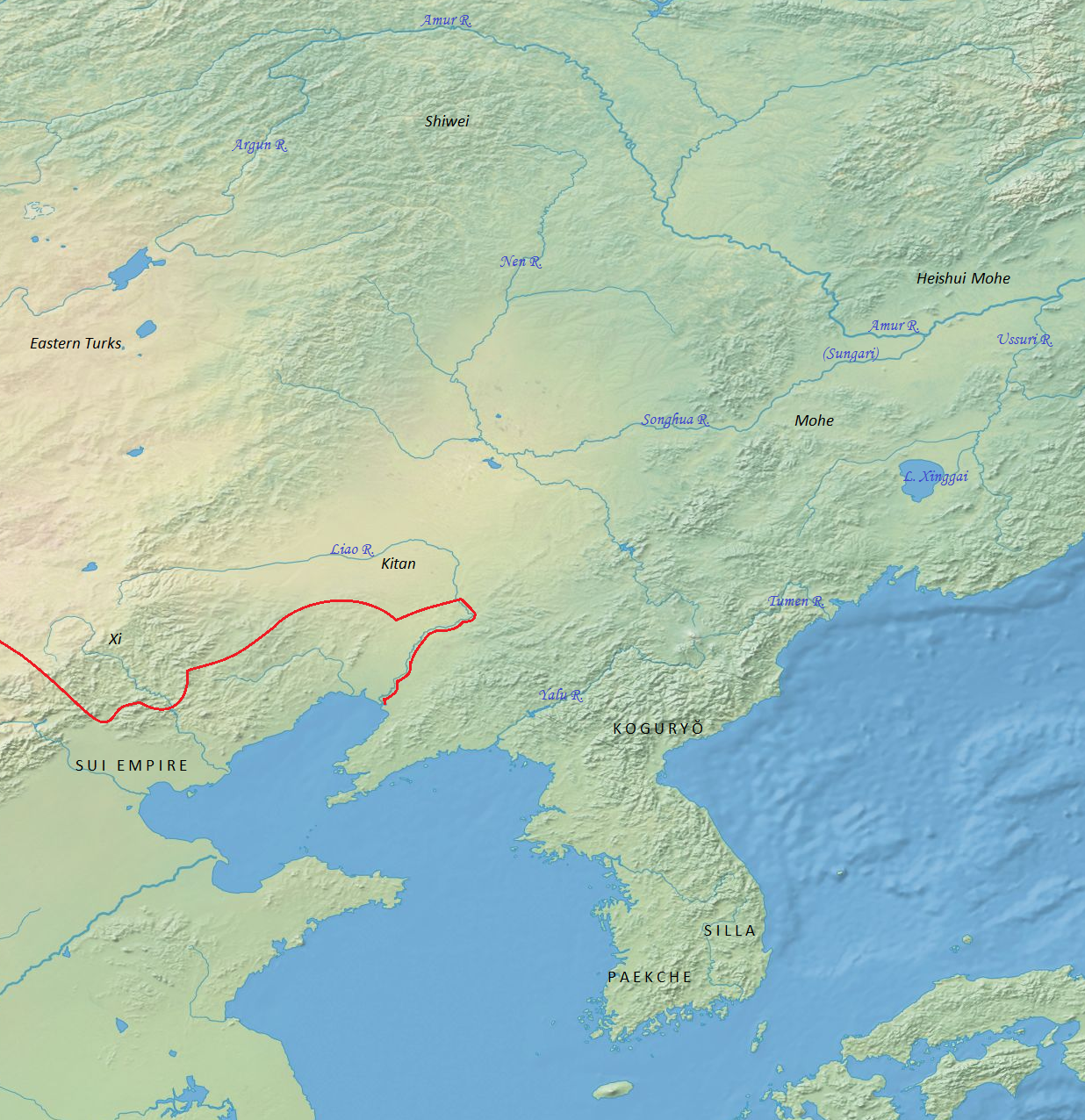The Xi 奚 were a nomad people living in the eastern parts of Mongolia between the 5th and 12th century. Some historians say they were a branch of the Yuwen 宇文 tribe of the Xianbei 鮮卑, yet other believe them to have been relatives to the Xiongnu 匈奴. During the Northern Wei period they were called Kumoxi 庫莫奚. They lived in the region of the River Siramuren and the River Laohe, Inner Mongolia, with the land of the Khitans 契丹 to the northeast. The Xi were pastoral nomads, lived in felt yurts and shifted their seats with the seasons.
 |
Northeast China and its surroundings c. 600 CE. Based on Tan Qixiang 譚其驤, ed. (1995), Zhongguo lishi ditu ji 中國歷史地圖集, Vol. 5, Sui Tang Wudai Shiguo shiqi 隋唐五代十國時期 (Beijing: Zhongguo ditu chubanshe, 1996). |
The Northern Wei forced tributes upon the Kumoxi. From the Sui period on their name was abbreviated to Xi, and they were divided into five tribes, in Chinese sources called Rugeyu 辱紇玉, Mohefu 莫賀弗, Qigu 契箇, Mukun 木昆 and Shide 室得. The tribesleaders were called yijin 俟斤 (native form irkin). The most powerful chieftain was a certain ahui 阿會 who was able to gain leadership over all Xi tribes. The Xi themselves were first vassals of the Türks 突厥 who called them Tatabi.
In 648 the Xi became vassals of the Tang empire 唐 (618-907), and the Tang court installed the area command (dudufu 都督府) of Raole 饒樂 in the land of the Xi. The highest chieftain of the Xi was bestowed the title of commander-in-chief (dudu 都督) and allowed to bear the imperial family name Li 李. The various Xi tribes were then living in indirectly administered prefectures (jimizhou 羈縻州) headed by a chieftain. In 696 the Xi and the Khitans discarded the yoke of the Tang and became vassals of the Western Türks, but in 715 again declared their submission to the Tang. The Tang court gave the highest leader of the Xi, Li Dapu 李大酺, the title of Commandery Prince (junwang 郡王) of Raole and gave to him a Tang princess called Princess Gu'an 固安公主.
Li Dapu died in 720 during a campaign against the Khitans. He was succeeded by his younger brother Lusu 魯蘇 who was confirmed his post of commander-in-chief and given into marriage Princess Dongguang 東光公主. In 726 he was given the title of Commandery Prince of Fengcheng 奉誠郡王, and in 735 the protectorate of Fengcheng was founded. The good relations between the Xi and the Tang court continued. The Xi delivered tributes, and several dozen of them were selected to be sent to the Tang capital Chang'an 長安 (modern Xi'an 西安, Shaanxi). During the late Tang period the federation of the Xi disintegrated into an eastern and a western part. At that time the Xi were also suffering from the increasing power of the Khitans who often raided the territory of the Xi and enslaved many of them. From 906 on the Xi became part of the Khitan federation who founded the Liao empire 遼 (907-1125).
In the early 10th century the Xi were divided into the five tribes of the Yaoli 遙里, Bode 伯德, Aoli 奧里, Meizhi 梅只 and Chuli 楚里, the so-called "Five Xi Tribes" 五部奚 that were supervised by military commissioners (jiedushi 節度使). In 923 the Khitans assembled scattered groups of Xi and united them in a sixth tribe called Duogui 墮瑰, to the "Six Xi Tribes" 六部奚. Emperor Taizu 遼太祖 (r. 907-927) founded a Princely Xi Department (Xiwangfu 奚王府) in the central government for which his successor, Emperor Taizong 遼太宗 (r. 927-947) created the office of Counsellor-in-chief (zaixiang 宰相) and that of a and a Manager of the Khitan households (changgun 常袞 or changwen 敞穩).
The Khitans resettled some of their war captives in the land of the Xi, so that besides the Xi themselves, also Chinese and other peoples were to live. Emperor Shengzong 遼聖宗 (r. 982-1030) abolished the Department and merged the Aoli, Duogui and Meizhi into one single tribe and arranged groups of submitted peoples resettled in the territory of the Xi into two new tribes, in order to reach again the symbolic number of six tribes. The seat of the Prince of the Xi was located at the banks of River Tu 土河 (modern River Yehuzhen). In this place, Emperor Shengzu founded his Central Capital 中京 (Dading 大定; near modern Ningcheng 寧城, Inner Mongolia).
The Xi people during the 10th century partially followed the traditional nomad lifestyle, but also cultivated fields. The traveller Wang Ceng 王曾 reports in his Xingchenglu 行程錄 that the Xi lived in straw huts and ploughed the fields, breeded excellent sheeps and pigs, but also had camels and sometimes went out on longer hunting campaigns. The Xi also produced bronze and iron tools, carts, weapons and textiles. The elite of the Xi followed the custom of the Khitans and adopted the family name Xiao 蕭 that was normally that of the brides of the Khitan emperors.
In the late 11th century the Jurchens became stronger and stronger and often attacked the Liao empire. In 1122 the Jurchens had founded the Jin empire 金 (1115-1234) and raided the prefecture of Bei'an 北安 (modern Chengde 承德, Hebei). Xiao Xia 蕭霞, Prince of the Xi, could not but submit to the Jurchens. The military commissioner Elila soon also surrendered. A year later Xiao Gan 蕭幹 (Huilibao 回離保), residing at Mt. Jiangan 箭笴山, proclaimed himself emperor of the Xi and adopted the reign motto Tianfu 天復. Yet his empire only survived for eight months. Emperor Taizu of the Jin 金太祖 (r. 1115-1122) quelled the last rebellions of the Xi and appointed his general Talan 撻懶 marshal (junshuai 軍帥) of the Six Xi Tribes. The whole people of the Xi was integrated into the military system (meng'an mouke 猛安謀克) of the Jurchens. Inside this system the Xi merged with the many peoples living in northern China during the Jin period.